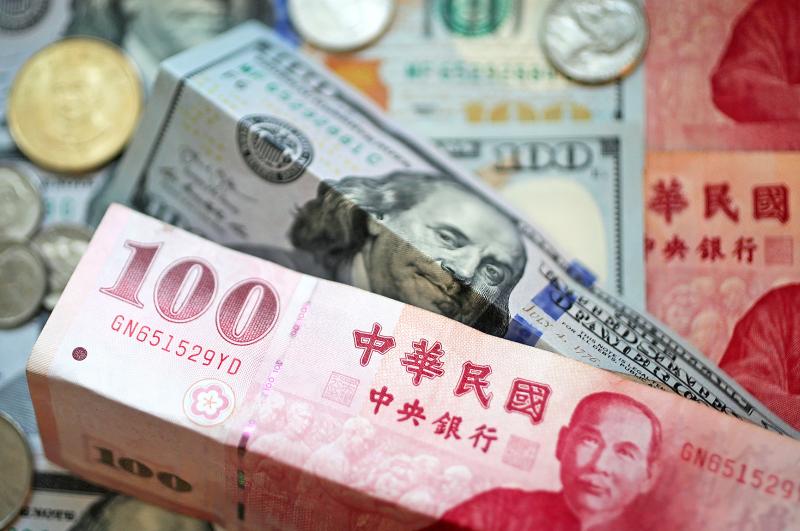Fund outflows from Taiwan reached a record high in the first quarter of this year, marking the 47th consecutive quarter of cash transferring out of the country, as the central bank attributed the pattern to overseas bond investments by Taiwanese financial institutions.
It was the third straight quarter that Taiwan reported record high fund outflows.
Data compiled by the central bank showed net outflows in Taiwan’s financial account — which measures the flow of direct investment and portfolio investment — totaled US$32.22 billion in the January-to-March quarter, up from US$18.56 billion a year earlier.

Photo: CNA
The first quarter’s fund outflow also beat the US$31.78 billion recorded in the fourth quarter of last year, the central bank’s statistics showed.
A spike in US Treasury yields prompted many Taiwanese financial institutions to park funds overseas after the US Federal Reserve introduced a rate-hike cycle that began in March, bank officials said.
The increase in net fund outflows came after portfolio investments abroad posted a net asset increase of US$49.92 billion, as insurance companies raised their investment in debt securities overseas, they said.
Out of the US$49.92 billion, residents’ portfolio investment abroad posted a net increase of US$35.21 billion on the back of a rise in overseas debt securities investment by insurance companies as well as other financial institutions, bank officials said.
Non-residents’ portfolio investment recorded a net fall of US$14.72 billion, as foreign investors reduced equity holdings in the local stock market in the first quarter, when the TAIEX shed 525.37 points, or 2.88 percent, after foreign institutional investors sold a net NT$459 billion (US$15.48 billion).
Over the past 47 quarters, accumulated net fund outflows hit US$660.51 billion, equivalent to more than seven years of Taipei’s tax revenue.
Addressing concerns that investors could continue to move funds out of the country and into US dollar-denominated assets, the central bank said that net financial account outflows are common among countries like Taiwan, which have a long-term current account surplus.
Other countries, like Japan, Singapore, South Korea and Germany, which have all had such a surplus, have also tended to record net financial account outflows, the bank said.
A current account mainly measures exports and imports of merchandise and services.
Taiwan in the first quarter recorded a current account surplus of US$30.68 billion, up US$4.85 billion from a year earlier, reporting a US$20.47 billion surplus in commodity trade, up US$1.7 billion from a year earlier, due to solid global demand for technology products amid a digital transformation.
Additionally, service trade reported a surplus of US$4.34 billion, a new quarterly high, due to increases in cargo shipping revenue amid tight supply, the central bank said.
Meanwhile, the central bank’s reserve assets rose only US$260 million, as the bank entered the foreign exchange market by selling US dollars to cap the depreciation of the New Taiwan dollar against a strong greenback.

CHIP RACE: Three years of overbroad export controls drove foreign competitors to pursue their own AI chips, and ‘cost US taxpayers billions of dollars,’ Nvidia said China has figured out the US strategy for allowing it to buy Nvidia Corp’s H200s and is rejecting the artificial intelligence (AI) chip in favor of domestically developed semiconductors, White House AI adviser David Sacks said, citing news reports. US President Donald Trump on Monday said that he would allow shipments of Nvidia’s H200 chips to China, part of an administration effort backed by Sacks to challenge Chinese tech champions such as Huawei Technologies Co (華為) by bringing US competition to their home market. On Friday, Sacks signaled that he was uncertain about whether that approach would work. “They’re rejecting our chips,” Sacks

NATIONAL SECURITY: Intel’s testing of ACM tools despite US government control ‘highlights egregious gaps in US technology protection policies,’ a former official said Chipmaker Intel Corp has tested chipmaking tools this year from a toolmaker with deep roots in China and two overseas units that were targeted by US sanctions, according to two sources with direct knowledge of the matter. Intel, which fended off calls for its CEO’s resignation from US President Donald Trump in August over his alleged ties to China, got the tools from ACM Research Inc, a Fremont, California-based producer of chipmaking equipment. Two of ACM’s units, based in Shanghai and South Korea, were among a number of firms barred last year from receiving US technology over claims they have

It is challenging to build infrastructure in much of Europe. Constrained budgets and polarized politics tend to undermine long-term projects, forcing officials to react to emergencies rather than plan for the future. Not in Austria. Today, the country is to officially open its Koralmbahn tunnel, the 5.9 billion euro (US$6.9 billion) centerpiece of a groundbreaking new railway that will eventually run from Poland’s Baltic coast to the Adriatic Sea, transforming travel within Austria and positioning the Alpine nation at the forefront of logistics in Europe. “It is Austria’s biggest socio-economic experiment in over a century,” said Eric Kirschner, an economist at Graz-based Joanneum

OPTION: Uber said it could provide higher pay for batch trips, if incentives for batching is not removed entirely, as the latter would force it to pass on the costs to consumers Uber Technologies Inc yesterday warned that proposed restrictions on batching orders and minimum wages could prompt a NT$20 delivery fee increase in Taiwan, as lower efficiency would drive up costs. Uber CEO Dara Khosrowshahi made the remarks yesterday during his visit to Taiwan. He is on a multileg trip to the region, which includes stops in South Korea and Japan. His visit coincided the release last month of the Ministry of Labor’s draft bill on the delivery sector, which aims to safeguard delivery workers’ rights and improve their welfare. The ministry set the minimum pay for local food delivery drivers at